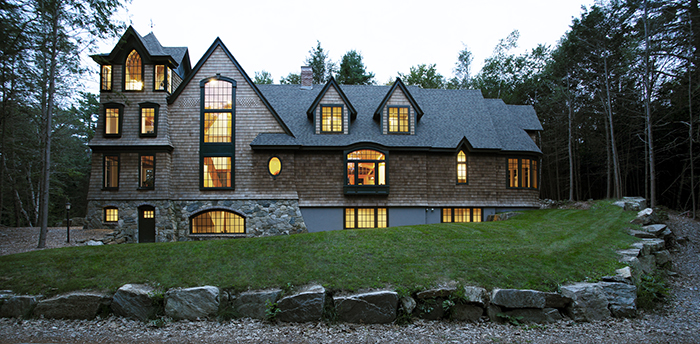
Size was limited when architectural glass was available only as plate glass in the 19th century, or as sheet glass in the first half of the 20th century. Muntin grids were introduced to facilitate larger glazed area for natural daylighting. The “muntin” is a small framing member appearing to separate two lites of glass.
With the advent of the float glass process after World War II, available glass size reached 7 feet or more in each dimension, but the aesthetic of the muntin grid’s appearance remained a desirable feature for traditional architectural designs.
For aluminum-framed window and door systems, architectural finishes offer an economical option to replicate historic copper and zinc, and a safer way to mimic lead. Finished aluminum also can offer the appearance of old steel framing or putty and wood-framed windows without the maintenance.
Muntin types
Depending on the manufacturer, muntins commonly are available as:
- “True divided lite” (TDL) bars or grids separating independently supported insulating glass units (IGUs),
- Tape- or silicone-applied individual pieces, or
- Between-glass muntins, secured in the hermetically sealed air space of the IGUs.
While TDL grids seem like the most elegant solution, inherent edge-of-glass conductivity issues can significantly increase thermal transmittance and the likelihood for condensation. Applied muntin grids provide a close resemblance to TDLs without sacrificing performance. Choosing between-glass muntins offers comparable performance with a modified appearance. Some manufacturers will combine between-glass and applied muntin grids for a modern update with the classic look and feel.
Muntin patterns
Today’s muntin grids can be crafted in a breadth of patterns:
- The regularly spaced grid is most popular in classic white painted finishes. It also is ideal in wood grain finishes to fit traditional styles like farmhouse, craftsman and cottage homes.
- A prairie pattern provides an interesting border on the glass of perpendicularly crossed muntins for homes built in a mid-century modern style. These decorative details look great in warm, earthy painted colors or a rich copper anodize.
- A diamond pattern as found in Tudor revival homes can use the natural metallics of anodized finishes from brass to dark bronze to match the medieval feel of these classic window features.
- Large, horizontally divided lites help organize the visual space of big expansive windows found in contemporary builds and benefit from bold black painted finishes or natural metallic tones of clear anodize.
- Spiderweb, sunburst, scallops and custom divided lite patterns can be finished custom colors to match the unique looks of Victorian to ultra-modern home designs.
- Muntin grid designs also can be weighted to one side of an individual window or door lite yet provide a symmetrical design when multiple units are mulled together.
Muntin finishes
Applied and between-glass muntin grids generally are finished separately from the framing members. This offers the choice of finishing the grids to match the framing or selecting a different color or finish type. For example, between-glass muntins will never be touched and could have a lower performance finish. In contrast, applied grids are very likely to be touched; therefore, they require a higher performance finish.
For exterior-facing muntin grids, choose the highest performance finishes for the greatest durability and longevity. For architectural painted coatings, specify AAMA 2605, and for anodized finishes, specify AAMA 611. Your finishing services provider can assist with meeting your project’s unique requirements.



